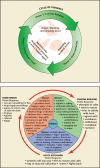Screening for intimate partner violence during pregnancy
- PMID: 24920977
- PMCID: PMC4002190
Screening for intimate partner violence during pregnancy
Abstract
Intimate partner violence (IPV) is defined as an actual or threatened abuse by an intimate partner that may be physical, sexual, psychological, or emotional in nature. Each year approximately 1.5 million women in the United States report some form of sexual or physical assault by an intimate partner; it is estimated that approximately 324,000 women are pregnant when violence occurs. Pregnancy may present a unique opportunity to identify and screen for patients experiencing IPV. This article provides health care practitioners and clinicians with the most current valid assessment and screening tools for evaluating pregnant women for IPV.
Keywords: Fetal risk; Intimate partner violence; Screening and detection.
Figures






References
-
- Basile KC, Hertz MF, Back SE. Intimate Partner Violence and Sexual Violence Victimization Assessment Instruments for Use in Healthcare Settings: Version 1. Atlanta, GA: Centers for Disease Control and Prevention, National Center for Injury Prevention and Control; 2007.
-
- Tjaden P, Thoennes N. Prevalence, Incidence, and Consequences of Violence Against Women: Findings from the National Violence Against Women Survey. 1998. Nov, [Accessed November 6, 2013].
-
- Gazmararian JA, Petersen R, Spitz AM, et al. Violence and reproductive health: current knowledge and future research directions. Mat Child Health J. 2000;4:79–84. - PubMed
-
- Black MC, Basile KC, Breiding MJ, et al. The National Intimate Partner and Sexual Violence Survey (NISVS): 2010 Summary Report. Atlanta, GA: National Center for Injury Prevention and Control, Centers for Disease Control and Prevention; 2011. [Accessed November 6, 2013].
-
- Liebschutz JM, Rothman EF. Intimate-partner violence—what physicians can do. N Engl J Med. 2012;367:2071–2073. - PubMed
Publication types
LinkOut - more resources
Full Text Sources
